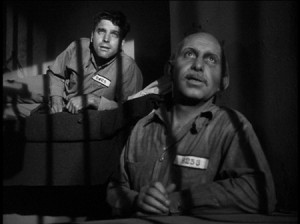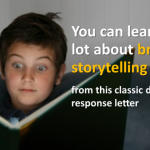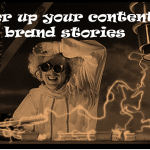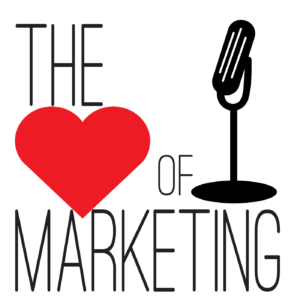A story can save boring content – except when you tell it wrong
Admit it.
You’re a sucker for a good story, right?
For good reason! Stories kindle your imagination. They make you feel something.
No wonder content marketers have glommed onto storytelling as a way to pierce through the noise and clutter of the internet and to grab the attention of their audience. Why?
The smart ones have figured out that stories have power to engage and persuade people in a way that statistics, facts or logical arguments can’t match. They give context and meaning to a complex and information-soaked world.
Just tell the story of your brand and bored readers will perk right up.
Hmm. If only it were that simple.
There is an art and science to good storytelling. If you’ve ever been trapped in a social setting by someone who tells rambling, incoherent stories, you know that all too well. It’s awkward and annoying. When it comes to telling your brand story, you don’t want to be that guy.
That awkward moment when your story fails miserably
The cell door clanked shut at the end of his first day in jail.
“Lights out,” said the guard.
The new guy lay quietly waiting for sleep to come.
After five minutes a voice down the corridor yelled out, “Forty three.”
The prisoners roared with laughter.
More quiet. Then another voice yelled, “Seventeen.”
Another chorus of laughs.
This went on for fifteen minutes more. Finally curiosity got the best of him. The new guy asked his cellmate why everybody laughed when a number was called.
“We’ve been in here so long that we’ve heard all the jokes everybody knows,” the cellmate explained. “We numbered them so we don’t have to tell the whole joke. Everybody knows the punchline by its number.”
“Twenty three,” called out another inmate. This time the cackles went on for a full minute.
Eager to get in on the fun, the new guy asked if he could tell one. “Go ahead,” his cellmate said.
 He cleared his throat and hollered, “Thirty seven!”
He cleared his throat and hollered, “Thirty seven!”
Dead silence.
After the longest minute of his life, he broke the silence.
“What happened?” he asked his cellmate. “How come nobody laughed?”
“You told it wrong.”
Yes, it’s an old joke. But it underscores the unfortunate result of getting storytelling wrong: rejection and indifference from your audience … two reactions to your content marketing you don’t want.
Here is where a little brain science can help you avoid that awkward moment.
All stories are visual
Ninety percent of information transmitted to the brain is visual. You frequently see this statistic cited as testimony to the importance of using images in content marketing. It applies to storytelling as well.
Here is how.
Stories activate your imagination, which triggers mental simulations in the brain. You visualize the situation in your mind’s eye, making it more concrete. In Made to Stick, Chip and Dan Heath explain it this way:
“When an audience hears a story, they simulate it in their mind. Stories put knowledge into a framework that is more lifelike, more true to our day-to-day existence.”
Mental simulations move your audience in powerful ways:
- They create a shared experience by engaging their emotions
- They create involvement by putting them into the situation
- They teach by giving meaning and context to situations
- They stick inside their head
- They motivate action
The right kind of story is a simulation. A mental simulation is not as powerful as being in the actual situation. But it’s the next best thing. Hearing ‘the new guy on the cellblock’ story isn’t the same as being there, but you can still experience it in similar ways.
That is the brain science behind storytelling. But as I mentioned above, there is also an art to it. How do you combine art and science to tell the right story?
The best marketers tell great stories
Because of how the unconscious mind works, how you tell a story is as important as what the story is. In Unconscious Branding, Douglas Van Praet says,
“The unconscious responds to the context or structure of a message not just the actual content, aware of how the information is delivered and not just what is said. This is why we use stories, poems, songs, jokes, pictures, metaphors. They are particularly ripe marketing tools, effectively bypassing critical analysis to evoke feelings that strike at the heart and gut.”
So how you structure your story has a direct impact on how it will be received by your audience. It doesn’t have to be complicated, but good story structure should have these characteristics:
A clear moral – What is the takeaway from this story? What is the reason why you are telling this story to this audience at this time?
A common reference point – Your audience needs to understand the context and situation of the story. Is there a point-of-view or universal experience they can identify with?
A protagonist – Make the audience or a relatable character the hero of the story, not your brand. The line between “audience” and “protagonist” can be blurred, so use that to help your audience enter into the story.
A relatable conflict – The story needs to show the challenges, struggles, vulnerability of the protagonist that the audience can relate to. Conflict generates interest in the outcome.
Descriptive narrative – The characters and setting need detailed descriptions that appeal to the senses. Paint a picture that stokes mental simulation.
Pacing – Quite simply, your story needs a beginning, a middle and an end. The ending should tie in with your main message or moral.
Today you need to tell stories to make your content marketing stand out with your audience. And you need to tell those stories well. The best marketers tell great stories that get inside the head of their audience and create a memorable experience.
The rest are telling it wrong.
Do you need help telling your brand story? Let’s talk! Message me to set up a time to chat on the phone.












Speak Your Mind